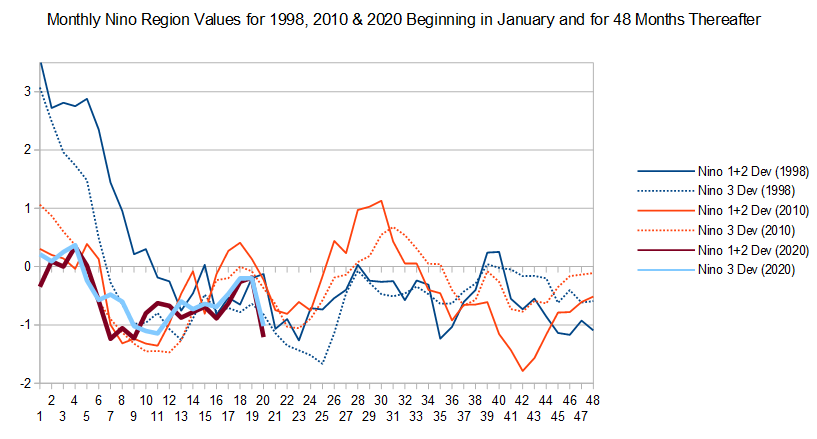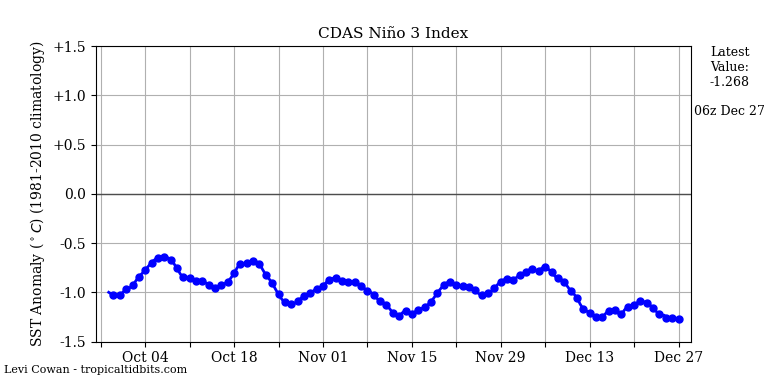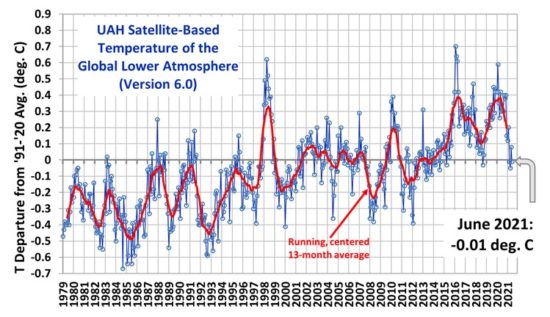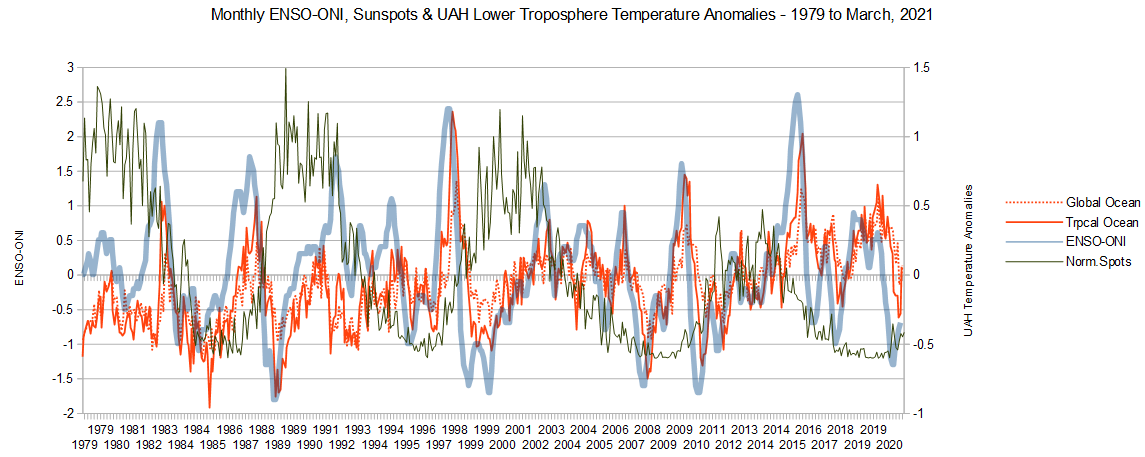|
|
Post by missouriboy on Jul 1, 2021 16:16:57 GMT
Missouri, my link to the historical weekly ENSO data isn't working. Do you have one that works? They seem to have stopped updating that some time back. I have been visually updating the weekly region values from Tropical Tidbits. I note that the recent end of month values have been consistently negative (reprocessing, averaging, 1-mth differences), versus the daily tracking values from Tidbits that have been positive. Region 4 has shown the greatest 1-month difference. Check back to Acid's post showing eastward push of higher temps. New end-of-mth values should be out in a couple of days.   |
|
|
|
Post by missouriboy on Jul 2, 2021 16:22:55 GMT
Following June ENSO conditions, UAH tropics and global troposphere anomalies for June should be steady or up slightly before dropping again into fall and winter. How deep? We need a poll. OK. So the June UAH global lower troposphere temperature anomaly declined again from May ... from +0.08C (May) to -0.01C (June). We will see where ENSO anomalies come in at. I will go out on a limb and forecast a global anomaly of -0.4C by year end. That would equal Nina 2011 levels. www.drroyspencer.com/latest-global-temperatures/ |
|
|
|
Post by blustnmtn on Jul 2, 2021 16:32:06 GMT
I’m sure State media will pick up on this…NOT.
|
|
|
|
Post by duwayne on Jul 2, 2021 18:43:52 GMT
Following June ENSO conditions, UAH tropics and global troposphere anomalies for June should be steady or up slightly before dropping again into fall and winter. How deep? We need a poll. OK. So the June UAH global lower troposphere temperature anomaly declined again from May ... from +0.08C (May) to -0.01C (June). We will see where ENSO anomalies come in at. I will go out on a limb and forecast a global anomaly of -0.4C by year end. That would equal Nina 2011 levels. www.drroyspencer.com/latest-global-temperatures/ Missouriboy, I'm glad that you are producing predictions with supporting rationale. That's what science is about. To me, someone making rational predictions is an order of magnitude more useful than just talk which is also often useful. Someone who makes predictions which prove accurate is another order of magnitude more useful.
Your prediction for a 2021 La Nina was right on.
One thing that I have learned is that it is much easier to be right when you predict temperatures to 0.1 degree accuracy rather than 0.01 degree.
|
|
|
|
Post by blustnmtn on Jul 2, 2021 19:19:59 GMT
OK. So the June UAH global lower troposphere temperature anomaly declined again from May ... from +0.08C (May) to -0.01C (June). We will see where ENSO anomalies come in at. I will go out on a limb and forecast a global anomaly of -0.4C by year end. That would equal Nina 2011 levels. www.drroyspencer.com/latest-global-temperatures/ Missouriboy, I'm glad that you are producing predictions with supporting rationale. That's what science is about. To me, someone making rational predictions is an order of magnitude more useful than just talk which is also often useful. Someone who makes predictions which prove accurate is another order of magnitude more useful.
Your prediction for a 2021 La Nina was right on.
One thing that I have learned is that it is much easier to be right when you predict temperatures to 0.1 degree accuracy rather than 0.01 degree.
|
|
|
|
Post by duwayne on Jul 2, 2021 19:39:59 GMT
To follow up on Missouriboy's prediction, I'll predict there will be a monthly UAH temperature of -0.1C or lower from this la Nina. I say this because the 2011 La Nina led to a monthly low of -0.4C. This one may not go that low but still probably has a little more to offer.
|
|
|
|
Post by Sigurdur on Jul 2, 2021 20:08:18 GMT
To follow up on Missouriboy's prediction, I'll predict there will be a monthly UAH temperature of -0.1C or lower from this la Nina. I say this because the 2011 La Nina led to a monthly low of -0.4C. This one may not go that low but still probably has a little more to offer. Agree |
|
|
|
Post by nonentropic on Jul 2, 2021 22:36:58 GMT
So the Solar cycle is the new variable and that is still not fully realized, early days in the cycle.
In my mind a serious slide in temperatures will work for the greater good. People such as Willy Soon and Easterbrook have set their positions a solid fall is the only hope to disrupt the revolution we are witnessing.
Hungry people think more clearly. Trade will solve a lot of distribution issues and prices will solve a lot of obesity and waste.
I have a target of -0.8C as a requirement for lasting change.
|
|
|
|
Post by missouriboy on Jul 3, 2021 2:32:29 GMT
So the Solar cycle is the new variable and that is still not fully realized, early days in the cycle. In my mind a serious slide in temperatures will work for the greater good. People such as Willy Soon and Easterbrook have set their positions a solid fall is the only hope to disrupt the revolution we are witnessing. Hungry people think more clearly. Trade will solve a lot of distribution issues and prices will solve a lot of obesity and waste. I have a target of -0.8C as a requirement for lasting change. The oceans are our baseload heat regulator. UAH lower troposphere temperature anomalies over the global and tropical oceans show a solar-driven stepped increase of about 0.5C since 1978. Take that back to the depths of the 60s-70s cool period and you may approach your 0.8C. If a second sequencial low solar cycle results in stepped up net ocean cooling, the question becomes ... how quickly do we step back down that ladder, and to what depth.  |
|
|
|
Post by nonentropic on Jul 3, 2021 5:04:53 GMT
Its a problem MB we lives in a slow boiled frog mode and we now trot ever so happily towards our Lemming destiny.
|
|
|
|
Post by blustnmtn on Jul 3, 2021 11:47:58 GMT
So the Solar cycle is the new variable and that is still not fully realized, early days in the cycle. In my mind a serious slide in temperatures will work for the greater good. People such as Willy Soon and Easterbrook have set their positions a solid fall is the only hope to disrupt the revolution we are witnessing. Hungry people think more clearly. Trade will solve a lot of distribution issues and prices will solve a lot of obesity and waste. I have a target of -0.8C as a requirement for lasting change. The oceans are our baseload heat regulator. UAH lower troposphere temperature anomalies over the global and tropical oceans show a solar-driven stepped increase of about 0.5C since 1978. Take that back to the depths of the 60s-70s cool period and you may approach your 0.8C. If a second sequencial low solar cycle results in stepped up net ocean cooling, the question becomes ... how quickly do we step back down that ladder, and to what depth.  I totally agree that the oceans of our blue planet hold the key. The interactions of the many parameters, which are little understood by humanity, influencing the behavior of the oceans have been changing the temperature of the earth locally and globally since the birth of the planet. Humans have consistently resorted to killing each other throughout their history. I’m betting neither has changed. |
|
|
|
Post by missouriboy on Jul 3, 2021 12:12:05 GMT
i am believing you are correct Blu. The trick will be to stay vertical long enough to collect on those bets.  Me thinks that the ride from warm to cool may be bumpier than generally appreciated. Jack and Jill Karen don't have a clue. |
|
|
|
Post by duwayne on Jul 3, 2021 20:24:53 GMT
So the Solar cycle is the new variable and that is still not fully realized, early days in the cycle. In my mind a serious slide in temperatures will work for the greater good. People such as Willy Soon and Easterbrook have set their positions a solid fall is the only hope to disrupt the revolution we are witnessing. Hungry people think more clearly. Trade will solve a lot of distribution issues and prices will solve a lot of obesity and waste. I have a target of -0.8C as a requirement for lasting change. The oceans are our baseload heat regulator. UAH lower troposphere temperature anomalies over the global and tropical oceans show a solar-driven stepped increase of about 0.5C since 1978. Take that back to the depths of the 60s-70s cool period and you may approach your 0.8C. If a second sequencial low solar cycle results in stepped up net ocean cooling, the question becomes ... how quickly do we step back down that ladder, and to what depth.  Why do you say the temperature increase is solar driven? |
|
|
|
Post by missouriboy on Jul 3, 2021 21:14:17 GMT
The oceans are our baseload heat regulator. UAH lower troposphere temperature anomalies over the global and tropical oceans show a solar-driven stepped increase of about 0.5C since 1978. Take that back to the depths of the 60s-70s cool period and you may approach your 0.8C. If a second sequencial low solar cycle results in stepped up net ocean cooling, the question becomes ... how quickly do we step back down that ladder, and to what depth.  Why do you say the temperature increase is solar driven? In the sense (indirect) that the oceans largely heat the troposphere, and the oceans are largely heated by the sun (primarily the shorter, more energetic wavelengths), with net oceanic temperature increases acruing during periods of stronger solar activity and decreases (less direct data) during periods of weaker solar activity. Other sources, such as planetary geothermal are discussed in the literature, but don't appear to be quantified. ENSO has major ocean-to-atmosphere heat transfer effects in the central-eastern tropical Pacific. At least that is my general thesis. |
|
|
|
Post by nonentropic on Jul 3, 2021 23:44:02 GMT
Any cyclic stuff you can see needs to be backed out of the background temperature changes.
Ultimately we know the temperature on earth has risen since the LIA what is not understood it seems is what is the driver. All discussions relating to CO2 are compromised by this undefined variable. The solar driver seems a good place to start.
So we have a modestly changing watts/M2 cyclical change small maybe even not material also linked to solar cycles. The elephant in the room is frequency content in that cyclic process. This looks to be a possible candidate for the changes we see.
We know that clouds and water temperature are impacted by the changes in this frequency content.
So what MB is doing in my mind is build a story about the cycles and then working out if they can be backed out of the data to allow a clear relationship of frequency and temperature to be visible or something else. Only then will we know the CO2 ECS.
|
|